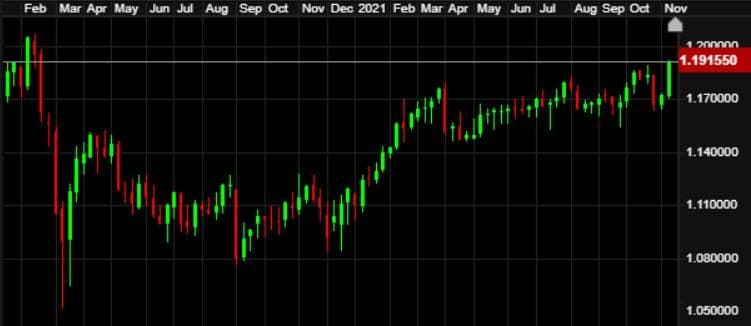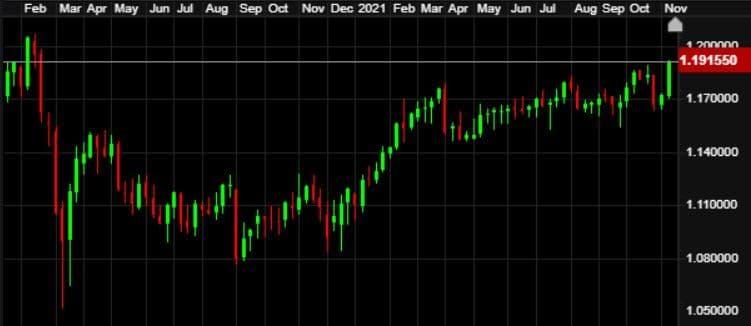Client Newsletter – 22-11-21
Inflation, inflation, inflation. Can we really still say the situation is transitory, or do we finally accept that a higher cost of living is here to stay? Figures released in the UK and Europe last week showed the picture is rapidly getting worse, adding fuel to the fire for an interest rate rise from the Bank of England in December.
As a result, we saw the highest GBP-EUR rates in 21 months. Meanwhile, you might well have a happy Thanksgiving this week if you are looking to sell US Dollars…
A challenging week for Europe last week on many different fronts, as COVID began to bite back in a similar way as it did last winter. Not only was the economic data concerning, but case rates in Austria have risen so much of late that the government was forced to implement a further lockdown, which starts today.
European uncertainty rattled financial markets throughout the week, with the Dollar the main beneficiary in its status as a major safe haven. Overall, the Euro took a hit of almost two per cent against the Dollar as a result. Riots and demonstrations in Belgium, Holland, Austria, Croatia and Italy over the weekend, will not have helped the picture either.
On top of news stories, there were plenty of economic data releases to get stuck into last week too. Not all of them were pretty mind you.
Tuesday saw unemployment data released for the UK, showing the overall unemployment rate continuing to fall to 4.3%, from 4.5% the previous month. A positive shift most definitely, but it is important to stress that these numbers are for the month of September when the furlough scheme was in its eleventh hour. The real test will be in a month’s time when the numbers for October might well give a truer picture.
Economic growth for the Eurozone still seems to be chugging along nicely with a figure of 2.2% for the quarter ending September. This follows on from 2% the previous quarter and seems to be in line with recent expectations from the ECB. Meanwhile in the US, high street spending continues to be ahead of that in other countries (certainly the UK), last month showing growth of 1.7%, well above estimates. The flip side is that might not be helping the inflation picture.
Speaking of which, UK inflation data released on Wednesday was the big talking point of last week. Last month, the year-on-year figure of 3.1% was somewhat skewed by the end of the Government’s “Eat Out to Help Out” scheme last September. This month however, there was nothing to hide behind and the major rise in consumer prices was plain for all to see.
As recently as a few months ago we were told, “inflation may hit 4% this year”, so the crack of dawn on Wednesday’s figure of 4.2% was frankly a bit of a shocker. For those of us in the UK it means our purchases are even more expensive. For those at the Bank of England’s Monetary Policy Committee (MPC), it might force their hand into an interest rate rise at their next meeting. Unless that is, they were already expecting such a figure already.
Some of the biggest factors in the increase in inflation included:
- Used car prices – Up by 27.4% since April 2021 amid global microchip shortages slowing the production of new vehicles.
- Gas bills – Up by 28.1% in the year to October.
-Electricity bills – Up by 18.8% in the year to October.
As a result, GBP surged all morning. Just the potential of an interest rate hike next month from the MPC, enough to attract investors to the pound and increase its value by two per cent for the week against the Euro, up to the highest levels seen in 21 months. Are we looking at 1.20 potentially in the coming weeks if the hype intensifies? Movements since the start of the pandemic can be seen in the chart below:

Eurozone inflation figures also filtered through on Wednesday, at a similar 4.1%. With the ECB still sat on their hands and seemingly accepting inflation as “transitory”, such a number did nothing for the fortunes of the Euro. As mentioned, the single currency was primarily driven last week by COVID case rates, restrictions and unrest.
US data was a little thin on the ground last week, so Thursday’s unemployment claims data is worth a mention. We saw 268,000 new unemployment claimants last week in the States, slightly worse than expectations of 260,000. The increase in COVID cases in Europe last week if anything saw the Dollar favoured in the markets, whilst it held station against a resilient GBP as shown in the chart below:

To close out the week, UK retail sales managed a slight positive figure to steady the ship a little. Whilst growth of 0.8% isn’t exactly a sign of a booming retail sector, hopefully Christmas spending may start to get that moving in the right direction in the November numbers. After all, if there is anything us Brits enjoy it is spending a fortune at Christmas!
So into the week ahead now which almost takes us to the end of November. On which note, US data this week is condensed into the first three days of the week with a bank holiday for Thanksgiving on Thursday, followed by the spending bonanza that is Black Friday.
Tuesday is the busiest in terms of events with Manufacturing and Services sector figures released throughout the day. These will cover the main markets in the Eurozone, the UK and US. Of the big European countries, German figures are likely to be the ones to cause the jitters, with the threat of further lockdowns and restrictions in the run up to Christmas. Expectations are for the US figures to be the best performers, with the UK following closely behind.
Wednesday has a few significant events, with a potential second interest rate hike on the cards from the Reserve Bank of New Zealand in the small hours of the morning (UK time). After a rate rise in their last meeting on 6th October, this could be a fraction early for a second, but the economy is performing well.
US preliminary GDP figures will also land on Wednesday, expected to show a quarterly growth of 2.2%. The biggest US event of the week (excluding the one with a lot of turkey) comes in the form of the Federal Reserve meeting minutes release on Wednesday evening UK time. Jerome Powell has been fairly clear in his plans for tapering and interest rate hikes over the coming months, so I wouldn’t expect any surprises here.
With Thursday likely to be quiet, we just have Bank of England Governor Andrew Bailey to focus on. His moderated discussion with a particular favourite economist of mine, Mohamed El-Erian, will as always be listened to for clues as to actions expected from the next Bank of England meeting on 16th December. After last month where Bailey was felt to have “overpromised and under-delivered”, don’t expect too much from the Governor.
With two per cent movements on a lot of pairs last week, it is as important a time as ever to be discussing with the team your latest FX need. GBP at a 21-month high versus the Euro should not be sniffed at, and we had a busy week last week helping clients manage their risk over the coming months. Make sure to get in touch via contact@astoncm.com or +44 (0)207 493 5555.
For any of our London-based clients, the Aston team will be exhibiting at The Business Show at ExCeL Centre this Wednesday and Thursday, on stand number B1460. Come and say hi if you are attending the show.
Have a great week.